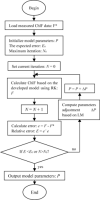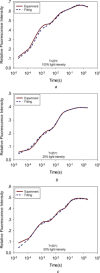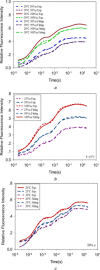Modelling and simulation of chlorophyll fluorescence from PSII of a plant leaf as affected by both illumination light intensities and temperatures
- PMID: 31778129
- PMCID: PMC8687186
- DOI: 10.1049/iet-syb.2019.0039
Modelling and simulation of chlorophyll fluorescence from PSII of a plant leaf as affected by both illumination light intensities and temperatures
Abstract
The emission of chlorophyll fluorescence (ChlF) from photosystem II (PSII) of plant leaves the couple with photoelectron transduction cascades in photosynthetic reactions and can be used to probe photosynthetic efficiency and plant physiology. Because of population increase, food shortages, and global warming, it is becoming more and more urgent to enhance plant photosynthesis efficiency by controlling plant growth rate. An effective model structure is essential for plant control strategy development. However, there is a lack of reporting on modelling and simulation of PSII activities under the interaction of both illumination light intensities and temperatures, which are the two important controllable factors affecting, plant growth, especially for a greenhouse. In this work, the authors extended their work on modelling photosynthetic activities as affected by light and temperature to cover both the interaction effects of illumination light intensities and temperature on ChlF emission. Experiments on ChlF were performed under different light intensities and temperatures and used to validate the developed model structure. The average relative error between experimental data and model fitting is <0.3%, which shows the effectiveness of the developed model structure. Simulations were performed to show the interaction effect of light and temperature effects on photosynthetic activities.
Figures




References
-
- Taiz L., and Zeiger E.: ‘Plant physiology’, Q. Rev. Biol., 2006, 167, (4), pp. 161–168
-
- Papageorgiou G.: ‘Chlorophyll fluorescence: an intrinsic probe of photosynthesis’, Bioenerg. Photosynth., 1975, 6, pp. 319–371
-
- Krause G.H., and Weis E.: ‘Chlorophyll fluorescence and photosynthesis: the basics’, Annu. Rev. Plant Biol., 1991, 42, (1), pp. 313–349
-
- Kennedy D., and Norman C.: ‘What don't we know?’, Science, 2005, 309, (5731), p. 75 - PubMed
-
- Zhen S.Y., and Iersel M.W.: ‘Photochemical acclimation of three contrasting species to different light levels: implications for optimizing supplemental lighting’, J. Am. Soc. Hort. Sci., 2017, 142, (5), pp. 346–354
Publication types
MeSH terms
Substances
LinkOut - more resources
Full Text Sources

